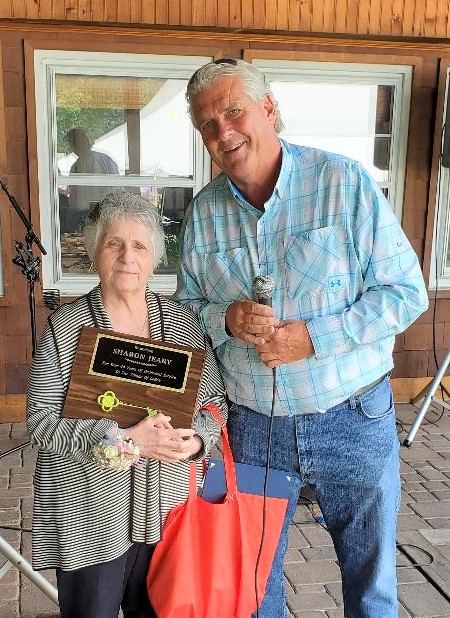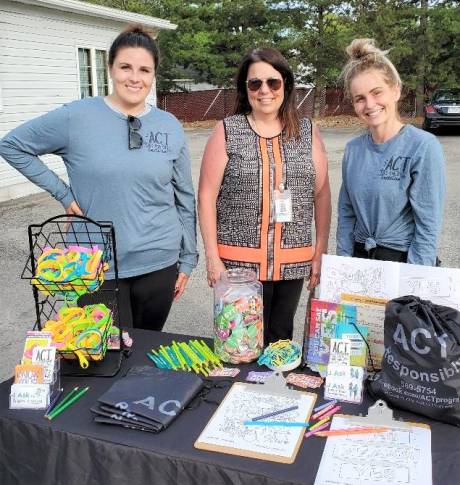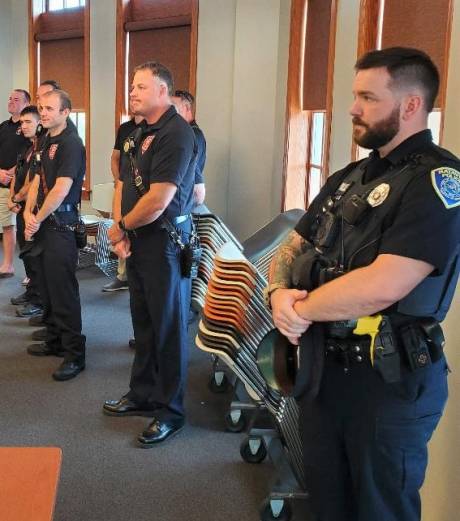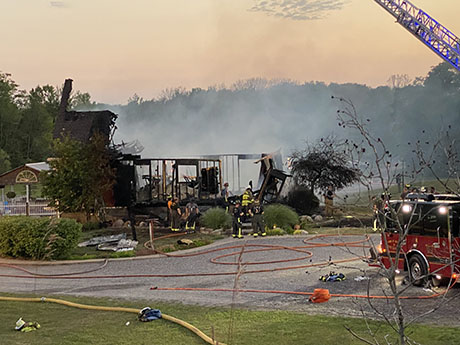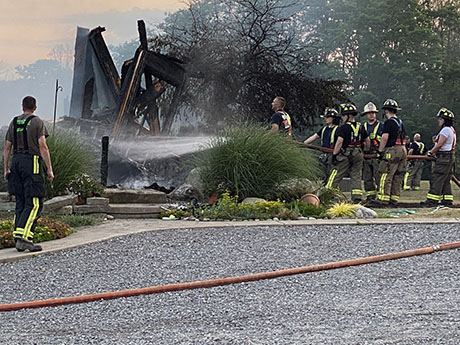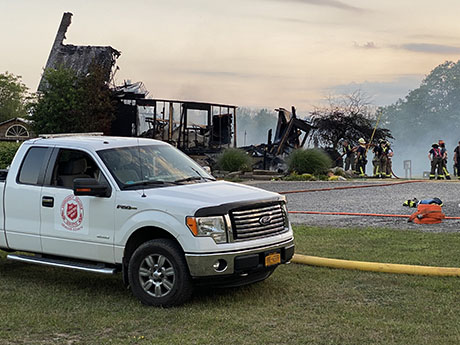Le Roy Town Board votes to rezone parcels adjacent to Le Roy Food & Tech Park after hearing residents' concerns
The Le Roy Town Board on Thursday night, citing its responsibility to enact measures to attract industry to its community, unanimously voted to rezone 185 acres in the vicinity of the Le Roy Food & Tech Park along West Bergen Road and Route 19 (Lake Street Road).
-------------
See related story below.
-------------
The board’s vote took place at 9:30 p.m. – 90 minutes after the conclusion of a public hearing on the issue of changing the zoning of seven parcels from R-2 (Residential) to I-2 (Light Industrial).
About 45 people attended the meeting at the Town Hall courtroom with the majority of the speakers coming out against the rezoning.
Those in opposition – mainly residents of Lake Street Road, West Bergen Road and Randall Road -- made impassioned pleas to the town board members to leave the R-2 zoning in place, with a couple individuals stating that any change that would open the door to manufacturing would forever destroy “our piece of heaven.”
The board, led by Supervisor James Farnholz, listened and responded – maintaining throughout that rezoning is consistent with the town’s Comprehensive Plan and the priority is to encourage business to create jobs and support the town’s property tax base.
In rendering its decision following the regular town board meeting, Councilperson John Armitage made the motion to rezone from R-2 to I-2 – light industrial only – for the parcels covered, and Farnholz seconded the motion.
All five board members voted “yes," with Deputy Supervisor Dave Paddock and councilpersons John Johnson and Ronald Pangrazio voicing their approval.
At that point, Armitage asked Town Attorney Reid Whiting if the town would “still have a lot of say on what can and can not occur there,” to which Whiting responded, “Absolutely … that this was just a preliminary step.”
Farnholz added that multiple public hearings would have to take place – considering all residents that would be affected -- prior to the placement of any industry in that location.
Much of the area residents’ concerns centered on speculation that Great Lakes Cheese, a large manufacturing industry based in Ohio, has approached owners of the parcels in question with potential offers to purchase their land should the company decide to build a $500 million processing plant in the Town of Le Roy.
Eric Raines Jr. of Lake Street Road, who has been outspoken in his opposition of rezoning, said he knows of neighbors who have been contacted by Great Lakes Cheese representatives and even had in his possession a conceptual map of the proposed plant drafted by an architectural firm representing the company.
Last night, Raines (an adjacent landowner) reiterated his viewpoints, stating that he and his girlfriend chose to purchase the historic Olmsted Manor and its 14 acres of woodlands because it was in an area that he believes is meant to stay “agricultural.”
He supported his claim with a Future Land Use map showing that part of the town colored green for agriculture.
“We found the town Comprehensive Plan and there are a couple maps published in (that plan),” he said. “One is a future use map; this is the future intended use of the land of Le Roy. This assures us that the land surrounding the manor was going to remain agricultural land. The existing land map said it was going to be agricultural and it is agricultural, and that future use map also said agricultural – green.”
Raines said that he found that this plan would be adopted until 2029, and that he decided to renovate the property with that in mind.
He also said that Farnholz has stated that the rezoning was not being done specifically for Great Lakes Cheese, and that the current R-2 zoning does support agriculture and farm-related activities.
“I think the town supervisor and those in favor of this rezone know the ‘super plant’ manufacturing facility is a wild stretch of the definition of farming-related activities,” he said. “If this according to the town supervisor is an agricultural industry, I ask … ‘What is considered a farming-related industry?”
Raines drew applause when he brought up that the town board had the opportunity to rezone the parcels over the past four years, but only moved to do so after Great Lakes Cheese entered the picture.
“Great Lakes Cheese offers $20,000 an acre. Two weeks later, the town submits to the county a rezoning,” he said. “… This rezone is to support Great Lakes Cheese.”
Farnholz shot back, however, stating that Raines – in a story on The Batavian earlier this week – said that “if you were offered four times the value for your property, we wouldn’t be having this conversation.” Raines then interjected, “I said we might not.”
The supervisor continued: “In the Comprehensive Plan it also states that additional economic development opportunities that arise in an around the Thruway, I-490 Interchange area, consistent with the county’s Smart Growth Plan and coordinate to ensure direct competition with existing town and village businesses.”
Whiting then said that the R-2 zone does support farm-related activities.
“The zoning ordinance is supposed to be consistent with the Comprehensive Plan, so this long-term goal is consistent with the contemplated change in zoning,” he said.
Undeterred, Raines said the Smart Growth Plan indicated the land to be rezoned is not considered “a developmental area” and that it is some of the best farmland in the county and warrants protection.
Farnholz countered, saying that the parcels along the Route 19 corridor “could be paved right now; it could be a mobile home park in a permitted use as it stands.”
At the outset of the public hearing Farnholz outlined the permitted uses in an R-2 district, which include single-family detached dwellings, churches and other religious buildings, parks and playgrounds, home occupation uses, home and farm gardens, agricultural buildings, garages, carports, swimming pools, tennis courts, and other larger, business-type structures with a special use permit.
Before closing, Raines submitted a petition against rezoning, signed by 10 residents of the three roads, and held up the conceptual map that he said was circulated by Great Lakes Cheese – “bullying the landowners into thinking that they had no option … it’s out of my hands, what can I do.”
Addressing the board, he drew another round of applause as he concluded, “You are a local government. You are here to protect us.”
Others who spoke during the public hearing, which lasted for an hour and 20 minutes, included the following:
Rebecca Hiler, Lake Street Road -- Stating that her property would be “completely surrounded by industrial,” she said she has done much work on her property. “This is my Zen, this is my home, this is my heaven, and you guys want to plop industrial right around me … How would you like this next to your house?”
Orion Hiler, Lake Street Road – Rebecca’s son, he said he has “felt blessed” to live at that location, having “escaped” Rochester and growing up in Le Roy. “I just see it (the aesthetics) ripped away and have this metallic monstrosity here, right in my backyard,” he said. “Having it rezoned so that semi-trucks passing in at all odd hours of the night to pick up cheese.”
Shane Hegeman, Lake Street Road – He said he opposed, citing concerns about the smell of a cheese plant. “Do you see anyone living around O-At-Ka Milk (Products in Batavia)?” he asked. “No, because that doesn’t belong in a neighborhood. We don’t need this.”
Charles Flynn, Randall Road – Noting that he is a real estate agent, he mentioned that many people in the Town of Byron are upset over the large solar system that is planned for that community and questioned whether property values would go down if the parcels were rezoned Industrial. “That’s why I question this Comprehensive Plan to try to adjust to the R-2 from the I-2 zone,” he said. “I don’t think we should make that change.”
Sarah Krzemien, Warsaw Road – She said she understands both sides of the issue, but questioned whether the town’s demographics would support the number of employees for a large industry in that area. “It just seems unnecessary, and none of us will benefit,” she said.
Kathy Glucksman, Randall Road – A longtime resident, she said that she and her husband recently refinanced their home to make improvements, and would be disappointed to find out that they would be surrounded by this industry. “It would decrease our property values, our quality of living and I believe there would be various health effects,” she said. “I urge you to protect us. If you look at our property, we are very vulnerable.”
Carol Konarski, Randall Road – A Randall Road resident for 46 years, she said she and her husband desired the peace and quiet and privacy of country living. “If you make this area an industrial area, that will be gone – it will be completely wiped out,” she said. “It’s just a little 100 by 200 (foot) plot, but it is our piece of heaven …” She added that her husband, who is deceased, would be “heartbroken if our dream that became a reality was destroyed.”
-----------
Other issues brought up focused on increased traffic on Route 19, noise, odor, glare and screening and setbacks from residential properties as a result of large-scale manufacturing. One individual wondered if the rezoning could be put to a vote of the residents.
Farnholz said that the matter is not subject to public referendum and, responding to a comment questioning the board’s level of concern, said that they all are on the board because they do care about the community.
“We’ve taken the time to run for elected positions and all of us represent everybody in the community on a variety and multitude of issues,” he said. “At the conclusion of this hearing tonight, we’ll be jumping into a solar issues … There’s reduced funding from Genesee County. We lost almost $700,000 last year in revenue sharing from the county.
“Do we care? Your taxes have not gone up. They went up 1 cent last year … So, we do care.”


















